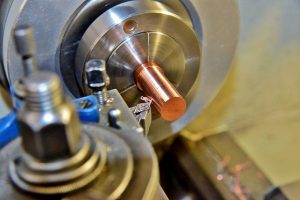
Facing operations are often categories as either lathe or milling, depending on the type of machine used. They involve the use of a machine to selectively remove material from the end or shoulder of a workpiece. The workpiece is secured to either a lathe or milling machine, after which it’s exposed to a cutting tool. The cutting tool then removes material from the workpiece until the desired size and shape is achieved. While both lathe and milling facing operations require the use of a machine to remove material from a workpiece, they aren’t exactly the same.
What Is Lathe Facing?
Lathe facing is a machining process that involves the use of a lathe. Lathes, of course, are heavy-duty and versatile machines that feature a stationary cutting tool and a rotating workpiece. This particularly machining process is known as turning. The workpiece is clamped or otherwise secured to the lathe, after which a cutting tool rotates while pressing against it. The rotational force of the lathe’s cutting tool allows it to dig out material from the workpiece, thereby reducing its size while simultaneously changing its shape.
What Is Milling Facing?
Milling facing, as you may have guessed, is a machining process that involves the use of a milling machine. Milling machines also have a cutting tool and a workpiece, but these components are essentially reversed when compared to lathes. In a lathe, the workpiece rotates against a stationary cutting tool. In a milling machine, the cutting tool rotates against a stationary workpiece.
Although there are exceptions, most milling machines don’t use a single-bladed cutting tool. Rather, they use a multi-bladed cutting tool. With multiple blades, the cutting tool is able to remove a larger amount of material from the workpiece than that of lathe’s cutting tool, which generally features a singe blade. Regardless, milling facing is a machining process that removes material from a workpiece by exposing the workpiece to a rotating, multi-bladed cutting tool.
In Conclusion
Lathe facing and milling facing are the two main types of facing operations. They are used extensively in the manufacturing industry to resize and reshape workpieces by exposing them to a cutting tool. The difference between lathe facing and milling facing is that the former involves the use of a lathe, whereas the latter involves the use of a milling machine. Hopefully, this gives you a better understanding of lathe facing and milling facing.
